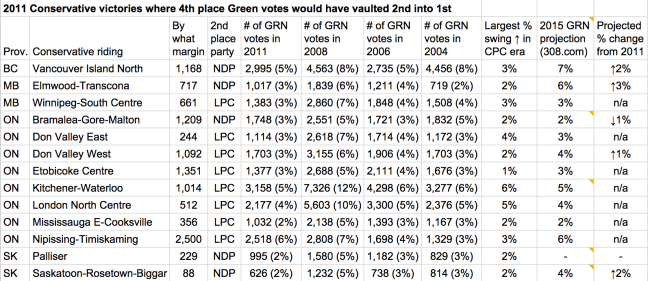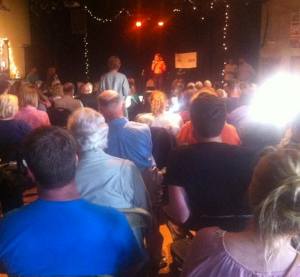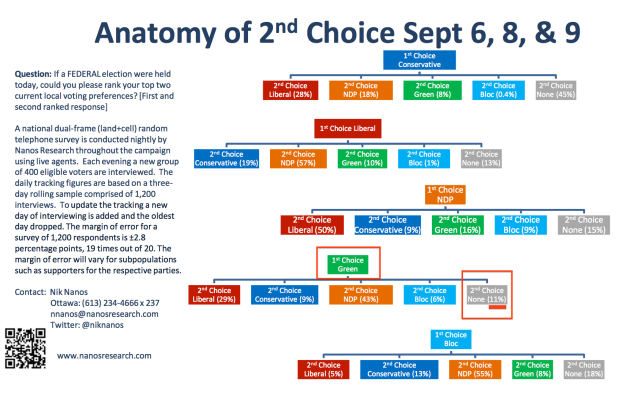Early this summer Elizabeth May wrote an opinion piece in which she used five ridings selected from provincial and federal elections past to argue that the Greens do not split the vote.
It is her central thesis for the 2015 election campaign, and I’ve heard it repeated by canvassers and candidates alike.
But is it true?
Disclaimer: This is not a hit piece. I have voted Green provincially twice. I live in Victoria, where the Conservatives have arguably their smallest chance of winning of any riding west of Toronto. A vote for Jo-Ann Roberts (GPC) is a vote for Jo-Ann Roberts; to claim otherwise would be unmistakably partisan.
That said, there are four claims in May’s piece that I find questionable, and I have pored over data from current polling as well as every federal election since the PC/Alliance merge in an effort to fact check them. Some of what I found changed my mind; some of it confirmed my suspicions.
Claim #1: Greens aren’t vote splitters.
We’ll tackle May’s thesis first.
Whether you personally define the Greens, Liberals, and/or NDP to be progressive is a post for another day. For the purpose of this post, I’ve defined a “progressive vote split” as follows:
A result in which the Conservative candidate won, and the candidate placing third received enough votes that, if they were added to the second place candidate’s votes, that would have vaulted the second place candidate over the Conservative candidate.
I looked at all 308 federal ridings from 2011, and found this to be the case in an impressive 47 of them. That’s close to a third of Harper’s 166 ridings won due to a progressive vote split. Applying the same methodology reveals a similar result in BC’s 2013 election.
Of those 47 Conservative ridings, the Greens placed third in only one of them (Yukon), but we’ll add Calgary Centre, as the Greens placed third there in a 2012 by-election.
If, for arguments sake, we add 3rd to 2nd in all those ridings (Calgary Centre included), we get:
47 fewer CPC seats
15 new NDP seats
32 new LPC seats
To put that in clearer terms, here is the 41st parliament with an organized progressive vote:
CPC 119 seats
NDP 118 seats
LPC 66 seats
BQ 4 seats
GRN 1 seat
Feeling wistful yet?
“But that operates under the assumption that all 3rd place votes would have gone to the 2nd place candidate.”
Yes, but if you look at the margin by which the 2nd place candidate would have vaulted over the Conservative winner, the average is 4,757.7 votes. If we split that margin evenly between the NDP, Liberals and Greens, a progressive candidate still wins in 37 of the 47 “progressive split” ridings, still putting Harper in a minority government position.
“But this is an argument as to why vote splitting is a problem in general, as opposed to the Greens in particular.”
Well said, particularly considering how the the NDP’s 2011 surge played out in parts of Ontario. Take Scarborough Centre: The NDP saw their vote share increase by 14.4% in 2011, almost all of which was at the expense of the Liberals. While all three parties were a factor in the race, this ultimately meant a Conservative victory in what had previously been a Liberal stronghold.
But let’s look deeper into the Greens’ numbers.
May claims that “removing all Green candidates and [their] entire vote [from 2011] does not change the Harper majority”. Besides being an accidentally good argument not to vote Green, this assumes Green supporters wouldn’t vote at all if the party didn’t run a candidate. But in the most recent poll by Nanos, only 9% of Green supporters selected “none” as their second choice of party. 37% chose NDP, 35% chose Liberal, 9% chose Conservative, and 7% chose Bloc Quebecois.
Here’s how close it was in 2011: Of the 47 “progressive split” ridings, 15 had a 4th place candidate whose votes, if added to the 2nd place candidate’s votes, would have easily vaulted the 2nd place candidate into 1st.
Of those 15 ridings, the Greens were that 4th place candidate 13 times. All were ridings in which the Greens were a distant fourth, and in every one of them the Greens haven’t come close to threatening to gain a seat in the entire post PC/Alliance merge era.
Harper got his majority by 11 seats.
Granted, the Greens are not the only reason for that. But if you are to accept that the NDP surge gave Harper seats in Ontario that would have gone Liberal, then you must also concede that the “Greens don’t split the vote” claim is empirically false.
Claim #2: Previous results are not useful predictors.
May cites the five ridings in which the Greens have experienced enough of a surge after consistently low results that they threatened to win a seat. They are:
Saanich—Gulf Islands (BC, federal)
May won Saanich—Gulf Islands in 2011, having led the federal Greens since 2006. It took losses in ridings in Ontario and Nova Scotia in ’06 and ’08 to develop enough of a profile to win on Vancouver Island, the most Green-friendly area in Canada.
Oak Bay—Gordon Head (BC, provincial)
This riding, which Andrew Weaver won provincially in 2013, overlaps with most of May’s riding. Leader, Jane Sterk ran in the riding adjacent to his and still lost.
Victoria (BC, federal byelection)
Victoria borders May’s riding and also contains Oak Bay. The Greens were narrowly defeated by the NDP in a 2012 by-election, and remain contenders in 2015.
Fredericton South (NB, provincial)
David Coon narrowly won in 2014. The riding’s boundaries had been redrawn, though not by much, and it should be noted Coon is a longtime colleague of May’s, but we’ll give her this one regardless.
Kellys Cross—Cumberland (PEI, provincial)
As for Kellys Cross—Cumberland, the Green provincial leader won in 2015, and this was after taking years to build up a profile, losing in nine different elections as a Green candidate before finally winning.
—
So what would be a more typical election-to-election pattern for the Greens?
The Greens had 3.9% of the national vote in 2011, 6.8% in 2008, 4.5% in 2006, and 4.3% in 2004.
For a representative riding-level sample, let’s consider those 13 ridings where the Greens placed 4th with enough votes in 2011 to vault the 2nd place candidate over the Conservative winner:
The largest swing upward the Greens experienced in any year in any of those ridings was 6%, and it went right back down in 2011, as it did in every riding on that chart after the Greens had performed measurably better in 2008. If anything, I could turn May’s logic around and in fact have more data to suggest that a swing upward for the Greens actually predicts a poorer result in the following election. Were I to be exactly as selective with my data as May has been, I could use London North Centre and Nipissing-Timiskaming as evidence that no one should vote Green ever.
But that would be cherry picking.
Even in the five ridings that May uses, previous results were a useful predictor, as they illustrated that strong Green results can indeed be achieved in a First Past The Post system — in or adjacent to ridings with party leaders who have taken years to build up a profile.
Where, outside of Vancouver Island, is that candidate in 2015?
Claim #3: Greens raise voter turnout.
May points out that in the four aforementioned ridings where a Green won, the voter turnout was extremely high; 90% in the case of Kellys Cross—Cumberland.
But that’s an argument that the Greens do better when the voter turnout is high; not that it’s specifically Greens who attract new voters and/or people who wouldn’t vote otherwise.
The national voter turnout did increase between 2008 and 2011, to the tune of 2.6%, or nearly a million votes. But the Greens went down in vote-share by 2.9%, which flies in directly in the face of May’s argument. Perhaps May is onto something in specific areas where the Greens have concentrated support from a national leader, but she provides no data that proves her broad claim that Greens raise turnout generally.
To be fair, recent Nanos polls do suggest between 9-14% of Green supporters don’t have a second choice, suggesting a portion of the Greens’ base may indeed stay home without them. But that isn’t nearly enough of a rallying point to woo NDP or Liberal supporters (or undecided progressives), who can bank on at least 85% of Green supporters considering a strategic vote.
Claim #4: The Conservative vote is shrinking.
This is a strong argument for May’s party — on Vancouver Island, where an Insights-West poll has the NDP at 39%, the Greens at 30%, and the Liberals and Conservatives at 15%. Insights-West called the closing of the gap between the provincial NDP and Liberals before Christy Clark’s surprise victory in 2013, so they have some credibility here.
At the time May wrote her piece the Conservatives’ national polling average (per threehundredeight.com) put them in second place at just over 28%, down four points from April, when they were in the lead at 32%. As of this writing they are still in second place, and their polling average, is, in fact, nearly two points higher at 29.7%. (This comes after a slide in early September when they dipped just below 27%, their lowest polling average of the campaign so far)
With just over a month before the election, there may be more room for Harper to shrink than grow, but every poll in the field shows his base not having budged, and remember, Conservatives redrew riding boundaries to suit how their base is distributed, so their seat count is going to be higher than their share of the popular vote would indicate. Just how high is still hard to say.
So where does that leave the Green Party?
The Greens consistently polled around 12-14% in BC throughout late August and early September, which is skewed by competitive numbers on Vancouver Island; Nanos most recently has the Greens down to 9%, with the Conservatives up as high as 30% (Forum has the Greens at 7% in BC, and the Conservatives at 28%).
Canada-wide the Greens don’t poll over 6%, and that includes BC. In fact, polling averages suggest the Green vote has shrunk nationally — by a point and a half since the beginning of September. As of this writing threehundredeight.com projects the Greens at over 15% in only two federal ridings outside of Vancouver Island; in neither are they over 20%. Threehundredeight got 88% of all ridings correct in 2011, and from election to election they average only 3.6 errors in number of seats per party.
So is the Conservative vote shrinking? It was when May wrote her piece, and has dipped since, but recent recovery suggests it hasn’t dipped enough for the Anything But Conservative movement to take its foot off the gas.
Conclusion
Elizabeth May calls vote splitting rhetoric “fear mongering.” Andrew Weaver has called it a form of voter suppression. While I am sympathetic to their concerns, the data says what it says. If the Conservatives start consistently tanking in the polls, then ABC voters might consider the Green candidate in areas, say, west of the Okanagan.
If the Conservatives maintain their base Canada-wide, though, then current polls don’t suggest the Greens are an option, unless you can point to strong riding-level polling and a Green candidate who has worked years to build up a profile.
Furthermore, Harper has cheated in every election he has won, and there’s no reason he won’t this time. He has stacked the deck against us with actual voter suppression tactics, and progressives need to be vigilant and at times pragmatic in order to defeat him. Sources like votetogether.ca will help.
What the Green Party needs is for Canadians to elect a government that will end First Past The Post; that, at least, is a realistic possibility, as the NDP is committed to mixed member proportional representation and the Liberals are committed to some type of electoral reform, such as PR or ranked ballots, pending further study (for what it’s worth the Law Commission of Canada recommended MMPR in a 2004 report).
Don’t mistake this as being patronizing; Speaking as a one-time Green voter, I would love a situation where a strong Green caucus could push for a basic livable income and stymie the other parties’ half-measures on environmental protections.
It just isn’t going to happen this time.
[Data I worked with may be found on this spreadsheet. Columns B through G are based on public domain data available through Elections Canada, Stats Canada, parl.gc.ca, and punditsguide.ca. Columns H & I are based on personal speculation only. Feel free to use any of what I’ve written and compiled to help spread the word. I just want us to win. Follow me on Twitter: @Taylewd]



